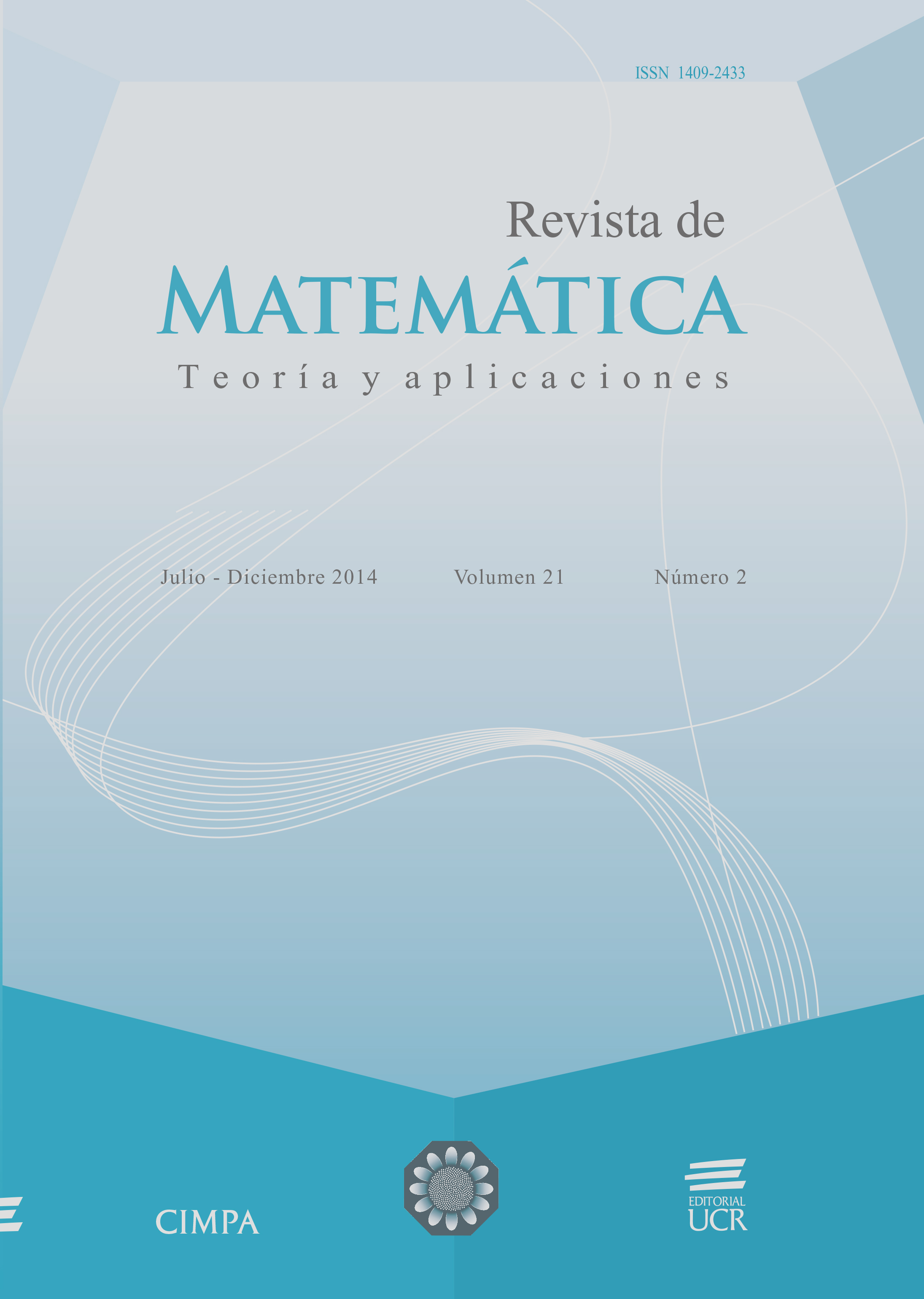Abstract
Some cases of poisoning by consumption of contaminated fish, like the Ciguatera poisoning, occur unexpectedly and they are not easy to detect previously since the fish that carry the toxin do not have appearance and/or symptoms of illness. In this paper a mathematical model for transport and acumulation of a toxin through a food chain is proposed. The model is a stiff system of ordinary differential equations that describes the dynamic. We propose a numerical scheme that combines a third-order Runge-Kutta method and trapezoidal rule to avoid the stiffness of the system. Several scenarios of toxin outbreaks are simulated; the results show that the time it takes to the toxin disappear in the trophic chain, depends on the state of the dynamics population at the time of the outbreak. This information can be used to set a ban on fishing until the toxin be reduced to harmless levels for the human health.
References
Arencibia, G.; Mancera, J.E.; Delgado, G. (2010) La ciguatera, un riesgo potencial para la salud humana: preguntas frecuentes, Universidad Nacional de Colombia, San Andrés Isla, Colombia.
Barton, E.D.; Tanner, P.; Turchen, S.G.; Manoguerra. A. (1995) “Ciguatera fish poisoning. A Southern California epidemic", Western Journal of Medicine 163(1): 31–35,
Chattopadhyay, J.; Arino, O. (1999) “A predator-prey model with disease in the prey", Nonlinear Analysis: Theory, Methods & Applications 36: 747–766.
Chattopadhyay, J.; Sarkar, R.R. (2003) “Chaos to order: preliminary experiments with a population dynamics models of three trophic levels", Ecological Modelling 163(1-2): 45–50.
Chattopadhyay, J.; Sarkar, R.R.; Pal, S. (2004) “Mathematical modeling of harmful algal blooms supported by experimental findings", Ecological Complexity 1(3): 225–235.
De Sylva, D.P. (1994) “ Distribution and ecology of ciguatera fish poisoning in Florida, with emphasis on the Florida Keys", Bulletin of Marine Science 54(3): 944–954.
de Fouw, J.C.; van Egmond, H.P.; Speijers, G.J.A. (2001) “Ciguatera fish poisoning: a review", RIVM report 388802021, Rijksinstituut voor Volks-gezondheid en Milieu (National Institute of Public Health and Enviroment, The Netherlands), Bilthoven
Egmond, H.P. van; Apeldoorn, M.E. van; Speijers, G.J.A. (2005) Biotoxinas Marinas. Estudio FAO: Alimentación y Nutrición, Organización de las Naciones Unidas para la Agricultura y la Alimentación (FAO), Roma.
Holling, C.S. (1965) “The functional response of predator to prey density and its role in mimicry and population regulation", Mem. Entoml. Soc. Can 97(S45): 5-60.
Lech, J.J.; Vodicnik, M.J.; Elcombe, C.R. (1982) “Induction of monooxygenase activity in fish"; Aquatic Toxicology 1(107): 415–418.
Kooi, B.W.; Bontje, D.; Voorn, G.A.K. van; Kooijman, S.A.L.M. (2008) “Sublethal toxic efects in a simple aquatic food chain", Ecological Modelling 212(3-4): 304–318.
Kubanek, J.; Hicks, M.K.; Naar, J.; Villareal, T.A. (2005) “Does the red tide dinoflagellate Karenia brevis use allelopathy to outcompete other phytoplankton?", Limnology and Oceanography 50(3): 883–895.
Lehane, L.; Lewis, R.J. (2000) “Ciguatera: recent advances but the risk remains", International Journal of Food Microbiology 61(2-3): 91–125.
Lewis, R.J.; Holmes, M.J. (1993) “Origin and transfer of toxins involved in ciguatera", Comp. Biochem. Physiol. C: Pharmacology, Toxicology and Endocrinology 106(3): 615–628.
Lewis, R.J. (2001) “The changing face of ciguatera", Toxicon 39(1): 97- 106.
Masayuki, I.; Keisuke, M.; Hisatoshi, U.; Megumi M.; Masahiro, H. (2004) “First- and second-generation total synthesis of ciguatoxin CTX3C", Proceedings of the National Academy of Sciences of the United States of America 101(33): 12013–12018.
Parson, M.L.; Settlemier, C.J.; Bienfang, P.K. (2010) “A simple model capable of simulating the population dynamics of Gambierdiscus, the benthic dinoagellate responsible for ciguatera fish poisoning", Harmful Algae 10(1): 71–80.
Pielou, E.C. (1969) An Introduction to Mathematical Ecology. Wiley-Interscience, New York.
Ruff, T.A.; Lewis, R.J. (1994) “Clinical aspects of ciguatera: an overview", Memoirs of the Queensland Museum - Nature 34(3): 609–619.
Sakamoto, B.; Nagai, H.; Hokama, Y. (1996). “Stimulators of Gambierdiscus toxicus (Dinophycease) growth: the possible role of gambieric acid-A as an endogenous growth enhancer", Phycologia 35(4): 350–353.
Sarkar, R.R.; Pal, S.; Chattopadhyay, J. (2005) “Role of two toxin- producing plankton and their efect on phytoplankton system – A mathematical study supported by experimental findings", BioSystems 80(1): 11–23.
##plugins.facebook.comentarios##

This work is licensed under a Creative Commons Attribution-NonCommercial-ShareAlike 4.0 International License.
Copyright (c) 2014 Revista de Matemática: Teoría y Aplicaciones





